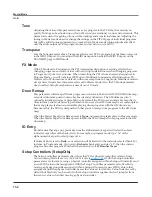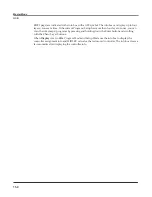
MIDI Mode
The RECEIVE Page
10-11
Continuous Controller Messages From External MIDI Devices
When using an external MIDI device with the PC3A, you can control many of the PC3A’s
program parameters by sending MIDI Continuous Controller messages (CCs) from the external
MIDI device. Each parameter that you wish to control must have a CC number assigned in the
Program Editor (see the section below:
Assigning An External CC Number As A Control Source For
A Program Parameter
.) See the sections below for details on using external CCs with the available
settings in Program and Setup Mode.
For details on controllable parameters of VAST programs, see the following sections:
The DSP
Modulation (DSPMOD) Page
on page 6-30
,
The LFO Page
on page 6-38
,
The ASR Page
on page 6-40
,
The Function (FUN) Page
on page 6-41
,
The Envelope Control (ENVCTL) Page
on page 6-45
,
The MOD
Pages
on page 9-10
, and
FXLFO, FXASR, and FXFUN pages
on page 9-11
. For KB3 programs, see the
following sections
KB3 Editor: The PITCH Page
on page 6-62
,
KB3 Editor: The AMP Page
on page 6-62
,
KB3 Editor: The LFO, ASR, and FUN Pages
on page 6-70
,
The MOD Pages
on page 9-10
, and
FXLFO,
FXASR, and FXFUN pages
on page 9-11
.
Assigning An External CC Number As A Control Source For A Program Parameter
For each program, the Program Editor can be used to assign an external MIDI controller CC
number for each controllable parameter in that parameter’s source field. Source fields are named
differently depending on their page: Src1, Src2, RateCt, Trigger, Input a, Input b, and Source. To
assign a CC number to a source field, enter the number with the alphanumeric pad, then press
Enter. With the source field selected, you can also assign a CC number by holding the Enter
button and sending a CC value from the external MIDI controller. When assigning a CC number
to a source field, the number may be displayed in the source field as the name of that CC’s default
use.
Using External CCs In Program Mode, Local Keyboard Channel=None
To control a program parameter via external MIDI CC in Program Mode, the parameter must
first have a
source assigned within the Program Editor, as described in the
Assigning An External
CC Number As A Control Source For A Program Parameter
section above. To control an assigned
program parameter with
Local Keyboard Channel
set to
None
, send the assigned CC number to
the channel which contains the program.
Using External CCs In Program Mode, Local Keyboard Channel Enabled
To control a program parameter via external MIDI CC in Program Mode, the parameter must
first have a
source assigned within the Program Editor, as described in the
Assigning An External
CC Number As A Control Source For A Program Parameter
section above. When using Local
Keyboard Channel in Program Mode, it is best to assign parameters to be controlled by the
default CCs for physical controllers, because these match the default destinations (see the
External MIDI CC Remapping For Local Keyboard Channel and Input Channel
table below for default
CCs).
The Local Keyboard Channel makes an external MIDI controller’s continuous controllers behave
as if they were the PC3A’s physical controllers. In Program Mode, when an external MIDI
controller is sending a CC on the channel set for
Local Keyboard Channel
, external CCs can
control the destinations set for each of the PC3A’s physical controllers. Send the default CC for a
physical controller to control its destination (see the
External MIDI CC Remapping For Local
Keyboard Channel and Input Channel
table below for defaults.) In Program Mode, these
destinations are set in the Control Setup
(see Control Setup
on page 6-9
for details.)
By default, the
destinations for the PC3A’s physical controllers are the same as their default CC numbers. To
control an assigned parameter, send the assigned default physical controller CC to the channel
set for
Local Keyboard Channel.
If a
Local Keyboard Channel
is set but you are sending CCs to a different channel, these CCs will
be received normally by the Program in that channel.
















































